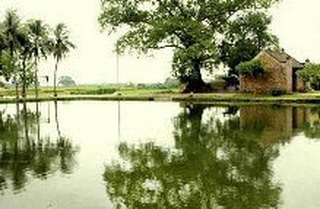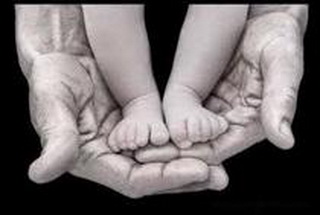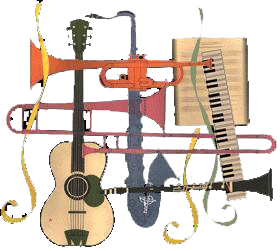
(Fig 1: The original Episcopal Falls Church in the city of Falls Church, VA)
Falls Church City
and the Vietnamese Boat People
Falls Church takes its name from an 18th century Episcopal church located on a tobacco rolling road, from the Little Falls of the Potomac River that runs through the capital. It is one of the wealthiest communities in America. However, more than three decades ago, our mailing address at 6319 Castle Pl, Falls Church, Virginia, might be misleading in that it was actually outside of the City of Falls Church, next to the seven corners created by the intersection of five major arteries that crossed this busy area of Northern Virginia. President Eisenhower brought Soviet Premier Nikita Khrushchev here as a showcase of capitalist lifestyle with its new Seven Corners Shopping Center.
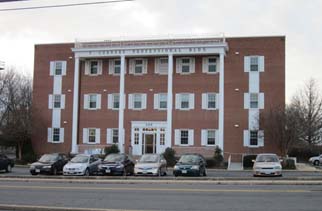 In December 1982, when we moved to the area, Seven Corners Mall had already been eclipsed by the new Tysons Corner Mall a few miles away to the West, and had lost its glamour as well as its wealth. The area was flooded with refugees from waves of Vietnamese boat people. With our family of five and practically no income, a rundown apartment near Arlington Boulevard was the only thing we could afford.
In December 1982, when we moved to the area, Seven Corners Mall had already been eclipsed by the new Tysons Corner Mall a few miles away to the West, and had lost its glamour as well as its wealth. The area was flooded with refugees from waves of Vietnamese boat people. With our family of five and practically no income, a rundown apartment near Arlington Boulevard was the only thing we could afford.
After two years, we bought a small house nearby, with a nice, shaded yard. It was for sale at a heavily discounted price (we were unaware that there was a housing bust then). I discovered it by pure serendipity only a short distance from our apartment after the manager decided to evict us for being overcrowded. That also explains how, after my residency, in order to be close to home and not too far from the hospitals, I chose an office in the same Seven Corners area. Additionally, there was a growing Vietnamese community in the surrounding neighborhoods.
In the last year of my residency, I allotted the entirety of my holiday weeks into the last month (June, 1986), so that I could open my private practice a little earlier. The real estate agent showed me the basement of an old office building, The 7 Corners Professional Building in Falls Church, Virginia, which made it more affordable and also made the owner more lenient regarding my credit history which at the time was negligible. I took the small office formerly occupied by an American family practitioner, who reportedly had died on the job, a few years earlier and whose medical records were still littered on the floor. I decided to practice general medicine in addition to pediatrics to have a broader patient base.
There was a growing community of Vietnamese expatriates in Northern Virginia and nearby southern Maryland, many of them spoke little English and knew little about American culture. My wife had been operating a small home child care business at home, and many of her customers easily became loyal new members of our practice. There were also people who had known us even from the time I was offering my free service as a doctor in the refugee camps in Malaysia and the Philippines. They were happy to find me here again in America. There is a Vietnamese saying for that emotion laden situation: “Tha hương ngộ cố nhân" (In other people‘s village, meeting old people, or simply: finding old acquaintance in a foreign land).
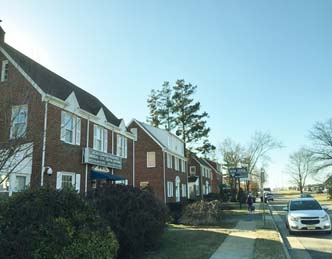 After three years, while waiting for my wife at a dental office, I discovered a 50 year old empty colonial house next door. It was a three leveled colonial brick house, which had been converted into an office for a real estate agency whose name was still on its oversized lighted sign box, facing the busy Arlington Boulevard. Again, it was only a few hundred yards from our first apartment. Our new sign read, in blue letters, quite predictably, “Seven Corners Pediatrics."
After three years, while waiting for my wife at a dental office, I discovered a 50 year old empty colonial house next door. It was a three leveled colonial brick house, which had been converted into an office for a real estate agency whose name was still on its oversized lighted sign box, facing the busy Arlington Boulevard. Again, it was only a few hundred yards from our first apartment. Our new sign read, in blue letters, quite predictably, “Seven Corners Pediatrics."
From the beginning of my practice, I saw that Vietnamese Americans badly needed information about health care written in their own language. Before the communist invasion of the country, South Vietnamese had very few health care related information readily available to them in plain native language. In the 1980’s, a few books, written by doctors in the 1960’s or 1970’s and reprinted in the US, were already obsolete with many inaccuracies. They were available at the bookstores at the nearby Eden Center where scores of small businesses ranging from grocery stores and restaurants to tax and medical offices were attracting Vietnamese customers from the mid- Atlantic states. There, one could get for free weekly newspapers in Vietnamese with occasional articles about adult health care, authored by a local internist-novelist or by a few doctors in other states who were eager to help with the education of the new immigrant community .
Vietnamese as a teaching language was used at the Saigon Medical School only since the mid 1960’s. And even before that, when French was the only teaching language, education in medical schools stressed facts memorization over learning the mechanism of diseases ("pathophysiology") and keeping up with advances in medicine. Most doctors, after they graduate, did not believe in explaining to patients about how the body worked or how to avoid diseases. Even if they did, Vietnamese medical terminology was not standardized yet and sounded mostly foreign even to the educated public. This matched with the patient's’ own expectations however. Doctors had to give them pills (usually antibiotics, which made sense then as treating infectious diseases was the main objective in tropical regions) rather than advice or lectures, or even better, a shot or an intravenous drip of vitamins to make them feel better, and quickly. Otherwise, they would switch to another doctor to get the job done more to their liking.
Taking care of Vietnamese-American children in the 1980’s, I had to deal with many particular cultural issues. In Vietnam still under economic embargo, food was lacking and condensed and sweetened milk or powdered milk (to be reconstituted with boiled water) were rationed as the only baby food available. New mothers had to let doctors or nurses examine their breast and certify that there was not enough milk production before they could get their meager ration of milk for their babies. Also, traditionally, for Vietnamese as well as for Chinese, ideal babies were big and fat babies. When they came to the US, many parents fed their babies as much as they could with formula, instead of breastfeeding them which is universally considered to be the best nutrition for a baby. Women had the widespread belief that their breasts were too small to give enough milk to feed the child, or for some reason the milk was not of a good quality. A free package of formula dispensed at the discharge of the baby from the hospital did not help the cause for breast feeding either. Besides, many of them were employed in low paying jobs in nail shops and restaurants that required them to leave home very early in the morning and come back home in the evening very late, only for sleep, seven days a week. Child care was delegated to babysitters or grandparents who did not know any English and could not tell the difference between whole milk and baby formula. Nutrition then was a major topic for discussion with a newborn’s parents, and it remained one of their major concerns as the child grew older, with the growth curve characteristic of their parents’ genetic and ethnic background. The next big questions to be addressed then were ”why my kid is so thin? why do his ribs show? why his height is not above the 50th percentile [of the general US population which has a more or less different genetic background]?"
A condition I frequently had to deal with at the beginning of my pediatric practice was severe iron deficiency anemia of toddlers due to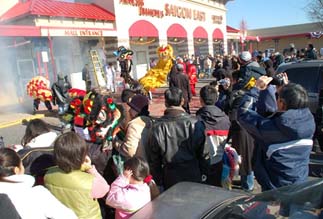 excessive amount of cow milk intake. The child would be full all day long with milk, not wanting to eat anything else, which alarmed the caretaker who then tried to feed him with even more milk. Babies would become obese and quiet, related to anemia. They gained weight rapidly because of the oversupply of proteins and calories provided by cow milk, but, as cow milk contained a very small amount of iron, their body did not have enough iron to manufacture red blood cells. Noticing the baby’s pale face and weight, doctors would take a blood sample only to find one half or one third the normal red blood cell count. The treatment was rather simple, just doses of iron drops, but the prevention required a lot of one on one explanation of basic disease processes, instructions and perseverance from the pediatrician.
excessive amount of cow milk intake. The child would be full all day long with milk, not wanting to eat anything else, which alarmed the caretaker who then tried to feed him with even more milk. Babies would become obese and quiet, related to anemia. They gained weight rapidly because of the oversupply of proteins and calories provided by cow milk, but, as cow milk contained a very small amount of iron, their body did not have enough iron to manufacture red blood cells. Noticing the baby’s pale face and weight, doctors would take a blood sample only to find one half or one third the normal red blood cell count. The treatment was rather simple, just doses of iron drops, but the prevention required a lot of one on one explanation of basic disease processes, instructions and perseverance from the pediatrician.
Similar problems became less frequent over the decades. As Seven Corners became “revitalized” with its thriving large chain stores like Home Depot, Barnes and Noble and Target, the Vietnamese moved out to better off suburban houses and the local apartments, now advertised as “luxury apartments”, are populated with new immigrants, mostly Hispanics. The Eden Center with its colorful Lion Arch and its Clock Tower, a replica of Saigon downtown landmark Ben Thanh Market, contains about
120 stores, and dubs itself “the heart and soul of the Vietnamese-American Community for the entire East Coast”. My patients now mostly speak English. Very few teenagers are fluent in Vietnamese, even those whose parents had compulsively taught them their mother tongue in their preschool years. Socialization in middle school, peer pressure and even their parents’ assimilation over the years are the main reasons for this language shift. This generation of patients is becoming more like the mainstream in that they have more obesity and allergy problems than those I saw three decades ago. Younger mothers are either second generation of Vietnamese Americans or Vietnamese brides who came to the US rather recently and, thanks to Youtube and a more open society in Vietnam, are better initiated to western lifestyle than refugees like us were decades earlier.
Hien V. Ho, MD
3-12-2015
Edited excerpt from the chapter My Life with Pediatrics: A Foot Soldier’s Saga, previously published in For Decades of Medical Training, Research and Practice: The Vietnamese-American Experience (1975-2015) by Nghia M. Vo, editor; chapter 4.
July 24, 2015


